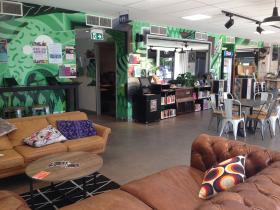Features and considerations: Identity and brand
Libraries are a focal point for the community, a place where groups and individuals meet, discuss, listen and learn. It is important that the community can relate to the library space and feel welcome.
The library building also serves an important civic function, both in terms of the service it provides and the image it conveys. A library should be expressive of its community. It must relate to the people it serves in an inviting, non-institutional and welcoming way. Creating an image and identity for your library does not need to be expensive. Primarily it is about developing an agreed vision for your library facility, through consultation and collaboration and then using this image to build a service and facility that the community knows and values.
Making libraries memorable: experience and brand
While the value of libraries in a digital world remains intact, library staff are aware of the range of competing sources of information, knowledge and recreational opportunities now available to their community. They are embracing their expanding role as community and cultural spaces, providing a broader scope of programs and public areas. To gain a competitive edge, they have embraced retail and business strategies, which focus on ensuring that library resources are easily seen and recognised, frequently used, and above all, convenient and memorable enough to attract subsequent visits.
To begin with, the act of visiting a library should be memorable. To achieve this, the library should provide an experience that is beyond the expected, fun or exciting, challenging, a wonderful place to be in, educational in unexpected ways and last in the memory. Libraries can create spaces which are experiences and learning tools in themselves. They have turned their attention to other learning environments such as museums and visitors’ centres, as well as commercial and retail sectors, for inspiration. Conventional storage of books often makes way for stimulating and engaging educational settings. Library spaces actively compete for recreational time against commercial alternatives and appear compelled to set their identity and create brand awareness so that their services are recognised.
Two potential models are:
- the museum model: libraries act as interpretive space, enhancing the learning experience beyond traditional collections
- the retail model: stimulating, merchandised and branded/themed space, capable of easily evolving over time.
Museum model
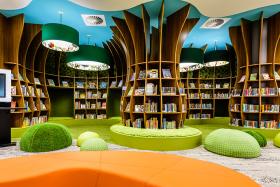
Interpretive libraries, like museums, are experienced as well as visited. For many years, museums have accepted that simply storing and displaying items is not enough to guarantee visitation. Creatively designed spaces which promote user involvement and enhance the experience of learning are far more effective and popular.
The librarian who commits to interpretive space does not rely on a static environment which remains the same from the day the library opens. Flexibility remains essential, allowing the space to evolve to meet user needs. Experiences within the library will change depending on client preference. Success requires the ability to experiment and innovate, and the enthusiasm and determination of the staff to test and replace environments depending on their effectiveness.
Creating successful interpretive space relies on a plan which identifies stories which can be told from themes of books, local or broader culture, historic and current events, exploration of user content, or the environment/cultural context. The interpretive environment can be elegantly integrated with the architecture or lean towards humour, even fantasy or kitsch.
The nature and quality of these environments varies significantly. Professional assistance can be sought from interior, graphic and exhibition designers, digital media professionals, architects and artists.
Aspiring to an interpretive environment should not be intimidating to the developers of libraries with smaller budgets and footprints. Artwork and installations can be sourced through local partnerships with schools, TAFE, universities, local history and local museum organisations and cultural/ multicultural organisations, as well as local artists and digital media enthusiasts.
Consider:
- graphic walls
- public art installations
- interpretive displays with semi-permanent exhibitions
- graphic glass and patterns either applied as film or integrated into glass structures
- suspension of banners and ceiling mounted installations
- fixed objects in children’s areas (sculpture, murals, cabinets, play equipment, even fish tanks)
- interpretation of historic/cultural information including artefacts, photos and text
- projection and digital display (can be interactive)
- interactive projection floor displays
- temporary exhibition space
- altered mood (for example dark, star-lit space for story time), and changes in finishes, textures and colour between spaces.
Children’s spaces can be greatly enhanced by interpretive environments, particularly if the space is shaped to the various levels of a child’s learning development allowing children to explore at an age appropriate level. Consider colour, texture, and places to explore and discover.
The active involvement of users with their library environment has become commonplace. They are provided opportunity to customise and contribute to their environment, adjust the furniture, create content, such as music, art, digital media, local history, and be involved in active learning programs. Libraries can inform users on sustainable living and building design through experiencing their library.
Retail model
Libraries compete for the community’s recreational time, which frequently involves trips to shopping centres, as well as electronic games and digital social networking environments. There is an expectation that environments will be stimulating, attractive and engaging. Many libraries are focusing on retailing and merchandising strategies. In particular, there is a focus on the display of the collection, creating exciting and inspiring environments as well as spaces which are easily navigated through interior design and signage.
Retail environments are increasingly sophisticated in their interior design. In environments such as shopping centres, the design frequently promotes itself as familiar or aspirational recreational space encouraging longer term stay and a sense of belonging. Activities beyond the core retail function are promoted as draw cards for clients. Libraries use similar inducements such as:
- music, AV collections and electronic games
- art collections
- recreational and cultural classes
- film nights
- book groups
- holiday programs and courses
- cafes, etc.
In offering recreational opportunities, the library can advertise its core activities as well as acting as a social hub, strengthening social cohesion and interaction. Libraries are frequently early in embracing new technology, with retail style fitouts seamlessly integrated with digital technology and audio-visual communication.
Marketing and branding
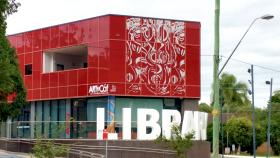
Contemporary libraries increasingly rely on their brand and branding. As the use of libraries changes, so has the perception of libraries. Marketing is critical in changing the community’s perception of the role of public libraries.
The need to differentiate and highlight the unique value of a library over alternate options for people’s valuable time has never been so critical. Perception of a library is developed far beyond a logo. All elements of the library, including the built environment, the facilities and programs offered, the convenience, the interior design, furniture selection and graphics will influence the perception of users and their opinion of a library’s brand.
A unified vision, if not a brand, will enhance the library visit experience. This includes changes made long after the designer has completed the initial work.
Built issues to consider:
- design excellence, iconic architecture or, at a minimum, transparent and identifiable design
- sophisticated and innovative interiors which provide contemporary, elegant and flexible approaches to signage, graphics, shelving displays, general layout and furniture
- provision and promotion of a range of spaces, both active and quiet
- street presence that is engaging and inviting (advertising interiors at night, transparent during the day), integrated with good external signage, and where necessary “Green” or ESD credentials and design
- flexibility for events, exhibition and performance (flexible wiring, AV points, ceiling mounting points)
- unified visual presence and ambience (graphics, architecture, interiors, signage, advertising)
- provision of creative content areas (production of digital media, AV, art, music)
- provision for interactive digital display and projection
- community involvement with library design, fitout and exhibitions
- outdoor breakout areas allowing a greater choice of settings and ability to host outdoor events
- modern interpretive museum exhibition design (particularly for local history, special collections)
- performance opportunities, sound, graphic walls, visual projection, sensory environments, lighting effects
- food outlets or flexibility to eat and drink
- play areas (at a minimum louder active children’s areas should be available).
Libraries with a unified visual presence
Burwood Library
Prior to 2020 renovations
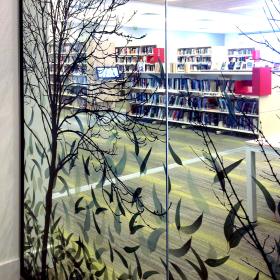
| 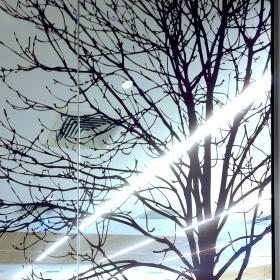
| 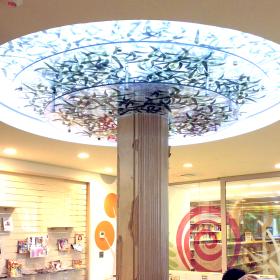
|
Oran Park Library
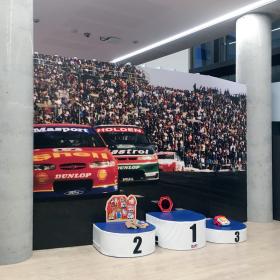
| 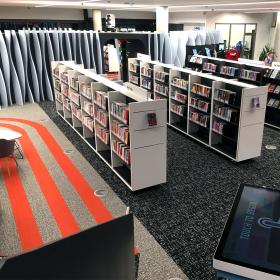
| 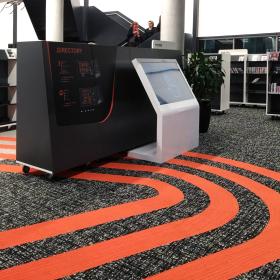
|
Rockdale Library
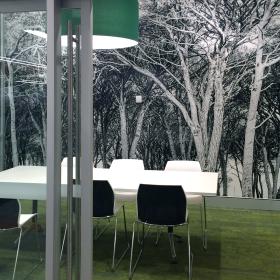
| 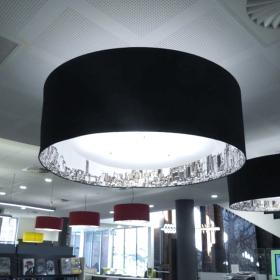
| 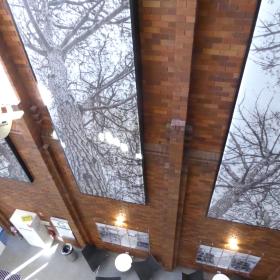
|
Design as marketing
In recent years, many public libraries have sought to improve their marketing through the adoption of various retail strategies in their physical design such as:
- the provision of flexible floor space which can be used for a variety of activities and experiences including courses and events
- weeding of collections to allow more space for display, particularly face out shelving
- creating memorable and exciting spaces
- furniture and shelving which is moveable, modular and changeable
- exhibition/display space which is appropriately lit, attractive and accessible
- adopting retail strategies, e.g. new trends in concept stores where a range of linked products are offered, or ‘one-stop-shops’
- in-house cafes, restaurants and stores
- themed areas, with considered consistent colours, graphics, materials, fittings and fixtures
- retail-influenced product display, where featured products are displayed prominently
